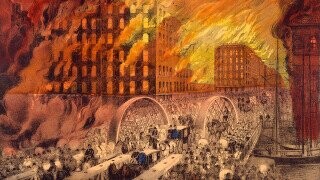How The Great Chicago Fire Gave Birth To The Skyscraper

Chicago, aside from New York, has more skyscrapers than any other city in the US. The Sears Tower, Trump International, St Regis (the tallest building in the world designed by a woman), the John Hancock Center (the tallest building in the world in the 1960s), and the Aon Center -- formerly known as the Standard Oil Building, and thus the most blowable building on this list.
The Windy City is the skyscraper capital, and there’s good reason for it. And that reason is … fire. Remember the Chicago Fire? Probably not, and if you do, howdy, Cracked-loving vampires and/or Highlanders. Why’d you try to blame that cow?

The Chicago Fire was one of the worst disasters of its time (if you don’t count the misogyny, racism, lack of penicillin, and industrial accidents involving child labor as disasters). It burned for three days, killing 300 people, destroying 17,000 structures, and inspiring the name of a terrible NBC show and mediocre soccer team.
After the fire, the world -- or, at least, one city in Illinois -- was changed forever. It was time to rebuild. Due to the advances in construction (and the, ya know, constant fear of fire), new buildings were not wood but iron, steel, stone.
Two years after the blaze, a man named William LeBaron Jenney, award-winner of Most Smug Sounding Name of the 1800s, was hired by the Home Insurance Company to make a fireproof building. That building would become the Home Insurance Building:

Ignoring the idea that a steel building could still burn down, Jenney set to work.
The building had a revolutionary design, much more lightweight than any building of its time or before, and this allowed the building to grow much larger than any ones of that time. Part of the reason for its design was the Home Insurance Company’s desire for it to have more natural light, which led to Jenney making the upper floors built on a steel frame -- allowing it to be lighter weight and just lighter.
At a whopping 10 stories, the Home Insurance Building was the first skyscraper and the inspiration for buildings like the Sears Tower (not calling it "Willis"), the Burj Khalifa, and the World Trade Center. Jenney’s work wasn’t done with this one building though, he and other architects formed the Chicago School, a group of architects who worked through the years to redefine buildings and create the idea of the modern skyscraper.
The Home Insurance Building was knocked down to put up another later on, but thanks to its innovative design, Spider-Man has things to swing from, King Kong buildings to climb, and we all get to watch Tom Cruise put his life at risk for little to no purpose.
Thanks, Tom.
Top Image: Currier & Ives